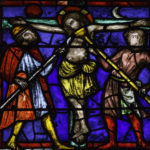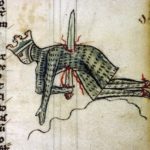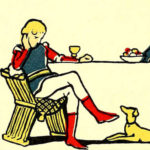We run our website the way we wished the whole internet worked: we provide high quality original content with no ads. We are funded solely by your direct support. Please consider supporting this project.

A Cruciform Magic Eye
In this post I’d like to share the story of how I came upon the thesis I’m defending in the book I’ve been working on for the last four years entitled The Crucifixion of the Warrior God: A Cruciform Theological Interpretation of the Old Testament’s Violent Divine Portraits. It’s a much longer post than usual, but if you’re one of the many Christians today who are deeply troubled by the violent portraits of God in the Old Testament, I believe you’ll find it worth the time spent.
Jesus, the One Word. To begin, in my previous post I called attention to the fact that Jesus is the Word of God (Jn 1:1). He is not one of the words of God. He is rather the only Word to which all other words of God point. This is confirmed by Jesus himself when he tells the religious leaders of his day that all Scripture bears witness to him and that he is the “life” of Scripture (which is why the religious leaders erred in thinking they could find life by studying Scripture without going further and embracing Christ) (Jn 5:39-40). And it’s also confirmed when the resurrected Jesus revealed that the law and prophets spoke not only of him, but of his sufferings and coming glory (Lk 24:25-27).
My point in reviewing this is to argue that Jesus must never be regarded as one Word among others. He is the Word to which all other inspired words point. And whatever else we take this to mean, it implies that the revelation of God in Christ, thematically centered on the cross, must never be compromised by anything else we find in Scripture. This, unfortunately, is precisely what most Christians throughout history have done, and what most Christian to this day continue to do. We take portraits of God commanding genocide, sending the flood, slaughtering cities, etc., and place them alongside of the cross, and then say, “All of this reveals God.”
Small wonder that so many have messed up mental pictures of God that they have trouble surrendering their lives to.
The Typical Two-Fold Strategy. To smooth over the contradictions between the cross and (say) the portraits of God commanding his people to slaughter every man, woman, infant and animal in Canaan, apologists typically engage in a two-fold strategy. First, they try to pull Christ in the direction of the OT’s violent portraits. Then they try to pull the violent portraits in the direction of Christ. The first strategy is typically carried out by appealing to Jesus’ cleansing of the Temple and especially by appealing to the Book of Revelation as a way of arguing that Jesus is one and the same as the God who commanded genocide and engaged in other violent acts. And the second is typically carried out by appealing to a multitude of considerations that make the violent portraits seem more Christ-like by stressing how the divine violence was justified and/or that it wasn’t as brutal as it on the surface appears to be. The best recent example of this is Paul Copan’s book, Is God a Moral Monster? (Baker, 2010).
Since I’ve always been disturbed by the OT’s violent portraits, I’d been collecting the best material that followed this two-fold strategy for over twenty years. And about four years ago I felt the need to take yet another break from a decades-long project I’ve been intermittently working on (called The Myth of the Blueprint) in order to finally resolve my own view and write a book on this topic.
My Initial Project. By this time, however, I had already become convinced that Jesus’ revelation of God as well as his kingdom ethic was thoroughly non-violent, so I abandoned all hope of pulling Jesus in the direction of the OT’s violent portraits. Among other things, the Temple cleansing was not an angry outburst, as some depict it, but a calculated symbolic act whereby Jesus fulfilled a messianic prophecy, exposed the sin of the Temple system, and forced the hand of leaders to arrest and crucify him, as was planned. More importantly, while Jesus’ actions were aggressive, there’s not a shred of evidence it involved violence, either to humans or to animals. Yes John mentions that Jesus formed a make-shift whip, but he also tells us what he used it for: he “drove all from the temple courts, both sheep and cattle…” (Jn 2:15). Cracking a whip on the ground has always been the primary way of controlling animals, and Jesus used it to create a stampede.
As for the Jesus of the book of Revelation, I became convinced about six years ago – and I’m even more convinced today – by the increasing wealth of scholarship that demonstrates that John appropriates violent symbols from the OT and from the violent apocalyptic literature of his day in order to subvert it. So, for example, Jesus is depicted as the mighty lion of Judah, but John immediately identifies him as, and later depicts him fighting as, a little slaughtered lamb (Rev 5:5-14). So too, John depicts Jesus slaying people with a sword, but it’s the sword of truth that comes out of his mouth, and it destroys lies (Rev 1: 16; 2:12, 16; 19:21; 19:15, 21). And in what looks like the most violent chapter of this book, and possibly of the whole Bible – Revelations 19 – John depicts Jesus using the standard imagery of a mighty warrior is drenched in the blood of the enemies he’s slain (Jn 19:13). Except in the case of Jesus, John depicts him as soaked in blood before he ever goes into battle, because as John reiterates throughout this book, the way this warrior fights is not by shedding the blood of others, but by allowing his own blood to be shed.
In any event, I have been persuaded by this growing list of scholars that Revelation is a violently anti-violent war scroll. That is, it encourages followers of the lamb to wage aggressive war against the principalities and powers as well as against the surrounding culture of Babylon (= all governmental systems under Satan’s reign, which means, all governmental systems). But they are to wage this aggressive war by following the example of Jesus and choosing to die rather than kill. Jesus’ warriors “follow the lamb wherever he goes” (Rev. 14:14) and overcome by “the blood of the lamb and the word of their testimony” (Rev. 12:11)). (I’ve included a sample reading list for those interested in pursuing this further.)
The REAL Problem. I had thus already abandoned the first strategy when I set out to write this book, but I yet held out hope for the second. As one who affirms that the OT is divinely inspired, what other option did I have? But as I pulled together all the violent portrayals of God in the OT (it’s quite overwhelming when viewed in a single glance), and as I began to work on the best formulations of the best arguments I’d found over the years defending these violent portraits, it didn’t take long before I despaired of this strategy as well. I found myself disbelieving the arguments even as I was writing them out! For I had begun to realize that, even if I succeed in making these horrific pictures look somewhat less heinous than they appear, and even if I were to succeed in showing the violence was justified – in fact, even if I succeeded in showing that they are somehow compatible with the revelation of God in Christ –I still wouldn’t have succeeded in doing what needs to be done.
What needs to be done is to show how the violent divine portraits “testifies to” Jesus – the Jesus whose identity and mission is summed up on the cross. Our task, in other words, is to show how the portrait of God commanding his people to “show no mercy” as they slaughter women and children, along with every other brutally violent portrait of God, actually points to the God who gave his life for his enemies on the cross, praying for their forgiveness with his last breath. Our task is to show how the crucified Christ is the Word that is spoken by these words – viz. the words that depict God commanding genocide!
A Different Way of Looking. I scratched the entire project. A radical reframe was needed. If there is any hope of demonstrating how the images of God as a warrior point to the crucified Christ, I came to see, I must find a way of discerning the crucified Christ in the violent warrior portraits, not in trying to formulate a relationship between the crucified Christ and these violent warrior portraits. And no sooner had I posed the problem this way when its solution suddenly appeared before me like a divine revelation (like a revelation – I’m not claiming this is a divine revelation!)
It felt a bit like viewing one of the “Magic Eye” pictures that look like a boring page of wallpaper patterns until you look at them in a particular way. When you don’t look at the patterns, but through the patterns, a 3D image that you couldn’t see before suddenly appears. So long as you look for the image as though it was on the same plain as the patterns, existing alongside of, or in competition with, the patterns, you won’t see it. Only when you look through them and into a dimension behind the patterns does the entirely different reality of the 3D image appear.
This is quite analogous to what happened with me. I stopped looking along side of the violent portraits to find ways of justifying them, and stopped looking for a relationship between these portraits and the cross, as though they were on the same plane. Instead, trusting on the authority of Christ that these violent portraits must somehow bear witness to the cross, I looked through them with the eyes of faith to discern the cross in the dimension behind them, as it were. Or to put it another way, believing that the God who “breathed” his full self-disclosure on Calvary was the one and same God who “breathed” these portraits (2 Tim 3:16), I looked for the God who is Calvary-like love behind these portraits.
The Magic-Eye Cross Appears. And then it appeared! I could see, at first in brief glimpses, but over time as a substantial reality, the crucified God in the depth dimension of the genocidal God. The God who bore our sin and God-forsaken judgment had always been bearing the sin and God-forsaken place of his people. The God who reflected the grotesqueness of our sin back toward us by taking on the guilty, God-forsaken semblance in the process of revealing himself, had always been reflecting the grotesqueness of his people’s sin by taking on a guilty, God-forsaken semblance in the process of revealing himself.
So too, the God who fully revealed himself not only by acting toward them, but also by allowing people and evil spirit agents to impact him with their sin, had always been revealing himself not only by acting toward people, but also by allowing people to impact him with their sin. And just as all that is beautiful in the cross reflects God’s true character while all that is ugly reflects the character of those he is trying to bring into a covenant relationship, so too all that is beautiful in any OT divine portrait reflects God’s true character while all that is ugly reflects the character of those he is trying to bring into a covenant relationship.
God only became a human and suffered to atone for the sin of the world once, in the crucifixion of Christ. But the fact that this single event reveals what God is truly like means it reflects what God has always been like. And when we fully embrace this and refuse to let it be compromised by granting authority to the horrifically violent warrior images, we are in a position to discern the crucified God in the portraits of the warrior God, and see in the crucified God the crucifixion of the warrior God.
There are, of course, a million other things to be said about this. My book is presently around 600 pages and looks like it may climb upwards to 700 before it’s complete. I’ll simply add that one of the most interesting and surprising things I’ve found – and it alone accounts for about 200 pages – concerns the way one can discern confirmations of this cruciform perspective in the very narratives containing these violent divine portraits as well as throughout the broader canon. This really blew me away!
At any rate, I hope to have my work completed within the next six months, which would mean it would be released around a year and a half from now. Also, I’ve devoted a chapter of my upcoming book, Benefit of the Doubt, to a brief look at the cruciform hermeneutic contained in Crucifixion of the Warrior God. This book is scheduled to be released in the Spring of 2013.
Til then, try the cruciform magic eye way of looking at these portraits. See if something doesn’t start to pop out at you.
Blessings,
Greg
Image by Shannon Kringen. Sourced via Flickr.
Suggested Reading
This is a sampling of the works that have helped convince me that Revelation is intended to call followers of Jesus to non-violent, self-sacrificial warfare against Satan and the powers and the political regimes under their control.
Bauckham, R. The Theology of the Book of Revelation (Cambridge: Cambridge University Press, 1993)
The Climax of Prophecy: Studies on the Book of Revelation (Edinburgh: T&T Clark)
Bredin, M. Jesus, Revolutionary of Peace: A Nonviolent Christology in the Book of Revelation (Carlisle, U.K/ Waynesboro, GA.: Paternoster Press, 2003);
Eller, V. The Most Revealing Book of the Bible: Making Sense out of Revelation (Grand Rapids, MI: Eerdmans, rpt 1982 [1974]).
Ellul, J. Apocalypse: The Book of Revelation, trans. W. Shriener (Seabury, 1967)
Gorman, M. Reading Revelation Responsibly: Uncivil Worship and Witness: Following the Lamb into the New Creation ( Cascade, 2011)
Hanson, A.T. The Wrath of the Lamb (Seabury, 1957)
Hays, R. The Moral Vision of the New Testament (HarperSanFrancisco, 1996)
Johns, L. L. The Lamb Christology of the Apocalypse of John (Mohr Sieback : Tübingen, 2003).
Kraybill, J. Apocalypse and Allegiance: Worship, Politics and Devotion in the Book of Revelation (Brazos, 2010)
Imperial Cult and Commerce in John’s Apocalypse (Sheffield Academic Press, 1996)
Neufeld, T. R. Y. Killing Enmity : Violence and the New Testament (Baker, 2011)
Pilgrim, W. Uneasy Neigbhors: Church and State in the New Testament (Fortress, 1999).
Swartly, W. Covenant of Peace: The Missing Peace in New Testament Theology and Ethics (Eerdmanns, 2006)
Tonstad, R S. K. Saving God’s Reputation: The Theological Function of Pistis Iesou in the Cosmic Narratives of Revelation (LNTS 337; Edinburgh: T & T Clark)
Yeats, J. Revelation (Herald, 2003)
Yoder, J. The Politics of Jesus (Eerdmans, rev. ed. 1994)
Category: General
Tags: Crucifixion of the Warrior God, Cruciform Theology
Topics: Interpreting Violent Pictures and Troubling Behaviors
Related Reading

What Does It Mean to Say a Narrative is Inspired Regardless of Historicity? (podcast)
Narratives, declaratives, and historical imperatives. Greg considers the relationship between the narrative and history. Episode 549 http://traffic.libsyn.com/askgregboyd/Episode_0549.mp3

The Perfect Love of God
The Father, Son and Spirit exist as the infinite intensity and unsurpassable perfection of eternal love. We know this about the triune God not by speculation but because Jesus demonstrated that love (Rom 5:8) in his willingness to go to the furthest extreme possible to save us. When the all-holy God stooped to become our…

Podcast: How Does God’s Wrath Fit within a Cruciform Theology?
Greg considers God’s wrath. http://traffic.libsyn.com/askgregboyd/Episode_0390.mp3

Cross Vision Coming Soon!
In Greg’s new book, Cross Vision, he explains how the crucifixion of Jesus makes sense of the violent portraits of God in the Old Testament. His groundbreaking “cruciform hermeneutic” will change the way that you read the Bible! While Crucifixion of the Warrior God laid out Greg’s case in detail for an academic audience, Cross Vision…

God’s Non-Violent Ideal in the OT
While God condescended to working within the violent-prone, fallen framework of his people in the Old Testament—as I argue in Crucifixion of the Warrior God—the OT is also full of references to how God worked to preserve his non-violent ideal as much as possible. He did this by continually reminding his people not to place…

Podcast: Is Open Theism an Accommodation?
Or for that matter is accommodation an accommodation? Greg talks about things that impact God. http://traffic.libsyn.com/askgregboyd/Episode_0407.mp3
